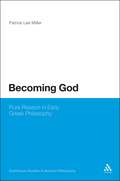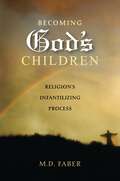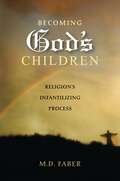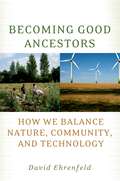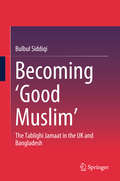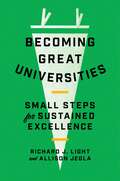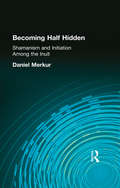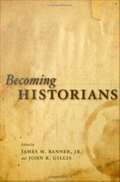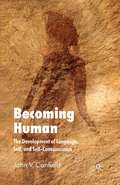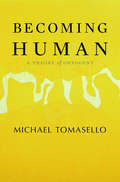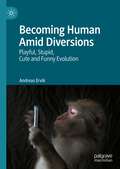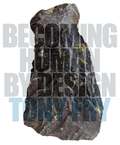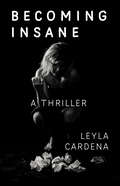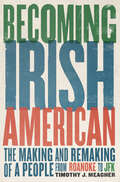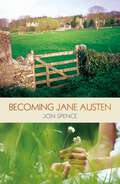- Table View
- List View
Becoming God: Pure Reason in Early Greek Philosophy (Continuum Studies in Ancient Philosophy)
by Patrick Lee MillerBecoming god was an ideal of many ancient Greek philosophers, as was the life of reason, which they equated with divinity. This book argues that their rival accounts of this equation depended on their divergent attitudes toward time. Affirming it, Heraclitus developed a paradoxical style of reasoning-chiasmus-that was the activity of his becoming god. Denying it as contradictory, Parmenides sought to purify thinking of all contradiction, offering eternity to those who would follow him. Plato did, fusing this pure style of reasoning-consistency-with a Pythagorean program of purification and divinization that would then influence philosophers from Aristotle to Kant. Those interested in Greek philosophical and religious thought will find fresh interpretations of its early figures, as well as a lucid presentation of the first and most influential attempts to link together divinity, rationality, and selfhood.
Becoming God's Children: Religion's Infantilizing Process
by M. D. FaberM. D. Faber presents a meticulous, unremitting inquiry into the psychological direction from which Christianity derives its power to attract and hold its followers.Becoming God's Children: Religion's Infantilizing Process was written, its author says, to alert readers to the role of infantilization in the Judeo-Christian tradition generally and in Christian rite and doctrine particularly. Because religion plays such an important role in so may lives, it is essential to understand the underlying appeal and significance of religious doctrines.To that end, Becoming God's Children offers the reader an in-depth account of human neuropsychological development, while unearthing the Judeo-Christian tradition's explicitly infantilizing doctrines and rites. This compelling perspective on the nature and meaning of religious behavior explores issues such as: to what extent religious faith is grounded in the mnemonic recesses of the worshipper's brain, whether believers are predisposed by both genetic makeup and environmental prompting to adhere to their religious convictions, and why some individuals are powerfully drawn to religious faith while others reject it. A final chapter explores the implications of religion's infantilizing process vis-a-vis the role of reason and scientific thought in the contemporary world.
Becoming God's Children: Religion's Infantilizing Process
by M. D. FaberM. D. Faber presents a meticulous, unremitting inquiry into the psychological direction from which Christianity derives its power to attract and hold its followers.Becoming God's Children: Religion's Infantilizing Process was written, its author says, to alert readers to the role of infantilization in the Judeo-Christian tradition generally and in Christian rite and doctrine particularly. Because religion plays such an important role in so may lives, it is essential to understand the underlying appeal and significance of religious doctrines.To that end, Becoming God's Children offers the reader an in-depth account of human neuropsychological development, while unearthing the Judeo-Christian tradition's explicitly infantilizing doctrines and rites. This compelling perspective on the nature and meaning of religious behavior explores issues such as: to what extent religious faith is grounded in the mnemonic recesses of the worshipper's brain, whether believers are predisposed by both genetic makeup and environmental prompting to adhere to their religious convictions, and why some individuals are powerfully drawn to religious faith while others reject it. A final chapter explores the implications of religion's infantilizing process vis-a-vis the role of reason and scientific thought in the contemporary world.
Becoming Good Ancestors: How We Balance Nature, Community, and Technology
by David EhrenfeldA brilliant writer and gifted "big picture" thinker, David Ehrenfeld is one of America's leading conservation biologists. Becoming Good Ancestors unites in a single, up-to-date framework pieces written over two decades, spanning politics, ecology, and culture, and illuminating the forces in modern society that thwart our efforts to solve today's hard questions about society and the environment. The book focuses on our present-day retreat from reality, our alienation from nature, our unthinking acceptance of new technology and rejection of the old, the loss of our ability to discriminate between events we can control and those we cannot, the denial of non-economic values, and the decline of local communities. If we are aware of what we are losing and why we are losing it, the author notes, all of these patterns are reversible. Through down-to-earth examples, ranging from a family canoe trip in the wilderness to the novels of Jane Austen to Chinese turtle and tiger farms, Ehrenfeld shows how we can use what we learn to move ourselves and our society towards a more stable, less frantic, and far more satisfying life, a life in which we are no longer compelled to damage ourselves and our environment, in which our children have a future, and in which fewer species are endangered and more rivers run clean. In the final chapter, he offers a dramatic view of the possibilities inherent in a fusion of the best elements of conservatism and liberalism. Our society has an inherent sense of what is right, says Ehrenfeld, and the creativity and persistence to make good things happen. It is now time to apply our intelligence, guided by our moral judgment, to the very large problems we all face. This book is an important first step.
Becoming ‘Good Muslim’: The Tablighi Jamaat in the UK and Bangladesh
by Bulbul SiddiqiThe book uses an ethnographic approach to explore why the Tablighi Jamaat movement remains so successful in contemporary times. It shows that this success results from the positive image that it cultivates, and the systematic preaching activities of Tablighi Jamaat followers, and that the organisation’s apolitical image, the public profile of the ijtema, the humbleness of Tablighi followers, and the attraction of belonging to the global Tablighi community all help to create a positive image of the Tablighi Jamaat among ordinary Muslims. The book also argues that the Tablighi Jamaat remains successful because of its ability to hold its followers within a Tablighi-guided life, which is perceived as protection against the Western lifestyle. Many elements of contemporary Western lifestyle are considered non-Islamic, and so by clearly defining what is Islamic and non-Islamic in modern society, the Tablighi Jamaat provides a way in which Muslims can live in the contemporary world, but remain good Muslims.
Becoming Great Universities: Small Steps for Sustained Excellence
by Richard J. Light Allison JeglaHow campus communities of every kind can transform themselves from good to greatBecoming Great Universities highlights ten core challenges that all colleges and universities face and offers practical steps that everyone on campus—from presidents to first-year undergraduates—can take to enhance student life and learning.This incisive book, written in a friendly and engaging style, draws on conversations with presidents, deans, and staff at hundreds of campuses across the country as well as scores of in-depth interviews with students and faculty. Providing suggestions that all members of a campus community can implement, Richard Light and Allison Jegla cover topics such as how to build a culture of innovation on campus, how to improve learning outcomes through experimentation, how to help students from under-resourced high schools succeed in college, and how to attract students from rural areas who may not be considering colleges far from their communities. They offer concrete ways to facilitate constructive interactions among students from different backgrounds, create opportunities for lifelong learning and engagement, and inspire students to think globally. And most of the ideas presented in this book can be implemented at little to no cost.Featuring a wealth of evidence-based examples, Becoming Great Universities offers actionable suggestions for everyone to have a positive impact on college life regardless of whether their campus is urban or rural, private or public, large or small, wealthy or not.
Becoming Habsburg: The Jews of Habsburg Bukovina, 1774-1918 (The Littman Library of Jewish Civilization)
by David RechterHabsburg Bukovina no longer exists, save in the realms of historiography, nostalgia, and collective memory. Remembered for its remarkable multinational, multi-faith character, Bukovina and its capital city Czernowitz have long been presented as exemplars of inter-ethnic co-operation, political moderation, and cultural dynamism, with Jews regarded as indispensable to the region’s character and vitality. This is not mere rhetoric: the Jews of Bukovina were integral to, and at home in, local society. David Rechter’s important new history conveys the special nature of Bukovina Jewry while embedding it in the broader historical and intellectual frameworks of Galician, imperial Austrian, and east central European Jewries. Carefully tracing the evolution of the tangled relationship of state and society with the Jews, from the Josephinian Enlightenment through absolutism to emancipation, he brings to light the untold story of the Jewish minority in the monarchy's easternmost province, often a byword for economic backwardness and cultural provincialism. Here, at the edge of the Habsburg monarchy, Jews forged a new society from familiar elements, a unique hybrid of eastern and western European Jewries. Bukovina Jewry was both and neither: understanding its history can help us grasp the east/west fault lines within European Jewry, a key element in the Jewish experience in Europe.
Becoming Half Hidden: Shamanism and Initiation Among the Inuit
by Daniel MerkurFirst Published in 1993. Routledge is an imprint of Taylor & Francis, an informa company.
Becoming Half Hidden: Shamanism and Initiation Among the Inuit
by Daniel MerkurFirst Published in 1993. Routledge is an imprint of Taylor & Francis, an informa company.
Becoming Hewlett Packard: Why Strategic Leadership Matters
by Robert A. Burgelman Webb McKinney Philip E. MezaBill Hewlett and Dave Packard invented the model of the Silicon Valley start-up and set in motion a process of corporate becoming that made it possible for HP to transform itself six times over the 77 years since its founding in the face of sweeping technological changes that felled most of its competitors over the years. Today, HP is in the throes of a seventh transformation to secure its continued survival by splitting in two independent companies: HP Inc. and Hewlett Packard Enterprise. Based on extensive primary research conducted over more than 15 years, this book documents the differential contribution of HP's successive CEOs in sustaining the company's integral process of becoming. It uses a comprehensive strategic leadership framework to examine and explain the role of the CEO: (1) defining and executing the key tasks of strategic leadership, and (2) developing four key elements of the company's strategic leadership capability. The study of the strategic leadership of HP's successive CEOs revealed the paradox of corporate becoming, the existential situation facing successive CEOs (that justifies the book's empathic approach), and the importance of the CEO's ability to harness the company's past while also driving its future. Building on these novel insights, the book shows how the frameworks used to conceptualize the tasks of strategic leadership and the development of strategic leadership capability can serve as steps toward a dynamic theory of strategic leadership that animates an evolutionary framework of corporate becoming. This framework will be helpful for further theory development about strategic leadership and also offers practical tools for founders of new companies and CEOs and boards of directors of existing companies who intend to create, run or oversee companies built for continued relevance, longevity and greatness.
Becoming Hewlett Packard: Why Strategic Leadership Matters
by Robert A. Burgelman Webb McKinney Philip E. MezaBill Hewlett and Dave Packard invented the model of the Silicon Valley start-up and set in motion a process of corporate becoming that made it possible for HP to transform itself six times over the 77 years since its founding in the face of sweeping technological changes that felled most of its competitors over the years. Today, HP is in the throes of a seventh transformation to secure its continued survival by splitting in two independent companies: HP Inc. and Hewlett Packard Enterprise. Based on extensive primary research conducted over more than 15 years, this book documents the differential contribution of HP's successive CEOs in sustaining the company's integral process of becoming. It uses a comprehensive strategic leadership framework to examine and explain the role of the CEO: (1) defining and executing the key tasks of strategic leadership, and (2) developing four key elements of the company's strategic leadership capability. The study of the strategic leadership of HP's successive CEOs revealed the paradox of corporate becoming, the existential situation facing successive CEOs (that justifies the book's empathic approach), and the importance of the CEO's ability to harness the company's past while also driving its future. Building on these novel insights, the book shows how the frameworks used to conceptualize the tasks of strategic leadership and the development of strategic leadership capability can serve as steps toward a dynamic theory of strategic leadership that animates an evolutionary framework of corporate becoming. This framework will be helpful for further theory development about strategic leadership and also offers practical tools for founders of new companies and CEOs and boards of directors of existing companies who intend to create, run or oversee companies built for continued relevance, longevity and greatness.
Becoming Hispanic-Serving Institutions: Opportunities for Colleges and Universities (Reforming Higher Education: Innovation and the Public Good)
by Gina Ann GarciaHispanic-Serving Institutions (HSIs);¢;‚¬;€?not-for-profit, degree-granting colleges and universities that enroll at least 25% or more Latinx students;¢;‚¬;€?are among the fastest-growing higher education segments in the United States. As of fall 2016, they represented 15% of all postsecondary institutions in the United States and enrolled 65% of all Latinx college students. As they increase in number, these questions bear consideration: What does it mean to serve Latinx students? What special needs does this student demographic have? And what opportunities and challenges develop when a college or university becomes an HSI? In Becoming Hispanic-Serving Institutions, Gina Ann Garcia explores how institutions are serving Latinx students, both through traditional and innovative approaches. Drawing on empirical data collected over two years at three HSIs, Garcia adopts a counternarrative approach to highlight the ways that HSIs are reframing what it means to serve Latinx college students. She questions the extent to which they have been successful in doing this while exploring how those institutions grapple with the tensions that emerge from confronting traditional standards and measures of success for postsecondary institutions. Laying out what it means for these three extremely different HSIs, Garcia also highlights the differences in the way each approaches its role in serving Latinxs. Incorporating the voices of faculty, staff, and students, Becoming Hispanic-Serving Institutions asserts that HSIs are undervalued, yet reveals that they serve an important role in the larger landscape of postsecondary institutions.
Becoming Hispanic-Serving Institutions: Opportunities for Colleges and Universities (Reforming Higher Education: Innovation and the Public Good)
by Gina Ann GarciaHispanic-Serving Institutions (HSIs);¢;‚¬;€?not-for-profit, degree-granting colleges and universities that enroll at least 25% or more Latinx students;¢;‚¬;€?are among the fastest-growing higher education segments in the United States. As of fall 2016, they represented 15% of all postsecondary institutions in the United States and enrolled 65% of all Latinx college students. As they increase in number, these questions bear consideration: What does it mean to serve Latinx students? What special needs does this student demographic have? And what opportunities and challenges develop when a college or university becomes an HSI? In Becoming Hispanic-Serving Institutions, Gina Ann Garcia explores how institutions are serving Latinx students, both through traditional and innovative approaches. Drawing on empirical data collected over two years at three HSIs, Garcia adopts a counternarrative approach to highlight the ways that HSIs are reframing what it means to serve Latinx college students. She questions the extent to which they have been successful in doing this while exploring how those institutions grapple with the tensions that emerge from confronting traditional standards and measures of success for postsecondary institutions. Laying out what it means for these three extremely different HSIs, Garcia also highlights the differences in the way each approaches its role in serving Latinxs. Incorporating the voices of faculty, staff, and students, Becoming Hispanic-Serving Institutions asserts that HSIs are undervalued, yet reveals that they serve an important role in the larger landscape of postsecondary institutions.
Becoming Historians
by James M. Banner John R. GillisIn this unique collection, the memoirs of eleven historians provide a fascinating portrait of a formative generation of scholars. Born around the time of World War II, these influential historians came of age just before the upheavals of the 1960s and ’70s and helped to transform both their discipline and the broader world of American higher education. The self-inventions they thoughtfully chronicle led, in many cases, to the invention of new fields—including women’s and gender history, social history, and public history—that cleared paths in the academy and made the study of the past more capacious and broadly relevant. In these stories—skillfully compiled and introduced by James Banner and John Gillis—aspiring historians will find inspiration and guidance, experienced scholars will see reflections of their own dilemmas and struggles, and all readers will discover a rare account of how today’s seasoned historians embarked on their intellectual journeys.
Becoming Historians
by James M. Banner John R. GillisIn this unique collection, the memoirs of eleven historians provide a fascinating portrait of a formative generation of scholars. Born around the time of World War II, these influential historians came of age just before the upheavals of the 1960s and ’70s and helped to transform both their discipline and the broader world of American higher education. The self-inventions they thoughtfully chronicle led, in many cases, to the invention of new fields—including women’s and gender history, social history, and public history—that cleared paths in the academy and made the study of the past more capacious and broadly relevant. In these stories—skillfully compiled and introduced by James Banner and John Gillis—aspiring historians will find inspiration and guidance, experienced scholars will see reflections of their own dilemmas and struggles, and all readers will discover a rare account of how today’s seasoned historians embarked on their intellectual journeys.
Becoming Historians
by James M. Banner John R. GillisIn this unique collection, the memoirs of eleven historians provide a fascinating portrait of a formative generation of scholars. Born around the time of World War II, these influential historians came of age just before the upheavals of the 1960s and ’70s and helped to transform both their discipline and the broader world of American higher education. The self-inventions they thoughtfully chronicle led, in many cases, to the invention of new fields—including women’s and gender history, social history, and public history—that cleared paths in the academy and made the study of the past more capacious and broadly relevant. In these stories—skillfully compiled and introduced by James Banner and John Gillis—aspiring historians will find inspiration and guidance, experienced scholars will see reflections of their own dilemmas and struggles, and all readers will discover a rare account of how today’s seasoned historians embarked on their intellectual journeys.
Becoming Human: The Development of Language, Self and Self-Consciousness
by J. CanfieldThis book is a philosophical examination of the stages in our journey from hominid to human. Dealing with the nature and origin of language, self-consciousness, and the religious ideal of a return to Eden, it has a philosophical anthropology approach. It provides an account of our place in nature consistent with both empiricism and mysticism.
Becoming Human: A Theory of Ontogeny
by Michael TomaselloVirtually all theories of how humans have become a distinctive species focus on evolution. Here, Michael Tomasello proposes a complementary theory focused on ontogenetic processes. Built on the essential ideas of Vygotsky, his data-driven model explains how those things that make us most human are constructed during the first six years of life.
Becoming Human Amid Diversions: Playful, Stupid, Cute and Funny Evolution.
by Andreas ErvikThis book develops a philosophy of the predominant yet obtrusive aspects of digital culture, arguing that what seems like insignificant distractions of digital technology - such as video games, mindless browsing, cute animal imagery, political memes, and trolling - are actually keyed into fundamental aspects of evolution. These elements are commonly framed as distractions in an economy of attention and this book approaches them with the prospect of understanding their attraction, from the starting point of diversions. Diversions designate not simply shifting states of attention but characterize the direction of any system on a different course, a theoretical perspective which makes it possible to investigate distractions as not only by-products of contemporary media and human attention. The perspective shifts from distractions as the unwanted and inconsequential to considering instead the function of diversions in the process of evolutionary development. Grounded in media theory but drawing from diverse interdisciplinary perspectives in biology, philosophy, and systems theory, this book provocatively theorizes the process of diversions – of the playful, stupid, cute, and funny – as significant for the evolution of a range of organisms.
Becoming Human by Design
by Tony FryThe last in Tony Fry's celebrated trilogy of books continues his radical rethinking of design. Becoming Human by Design's provocative argument presents a revised reading of human 'evolution' centred on ontological design. Examining the relation of design to the nature of the human species - where the species came from, how it was created, what it became and its likely future - Fry asserts that current biological and social models of evolution are an insufficient explanation of how 'we humans' became what we are.Making a case for ontological design as an evolutionary agency, the book posits the relation between the formation of the world of human fabrication and the making of mankind itself as indivisible. It also functions as a provocation to rethink the fate of Homo sapiens, recognising that all species are finite and that the fate of humankind turns on a fundamental Darwinian principle - adapt or die. Fry considers the nature of adaptation, arguing that it will depend on an ability to think and design in new ways.
Becoming Insane
by Leyla CardenaWhen the monsters hiding underneath your bed are much less frightening than the bills you have to pay, the family you have to support, the job you have to find, and the unrealized dreams you cry about, then you know there’s a problem. Especially when you are a full-grown adult in your mid-thirties. It’s 1987. John Crane feels like throwing himself out of the window because of his depression, while his friend Jack Vain has to support his spiraling O.C.D. and panic attacks. Their issues are driving them into a shared psychosis. Without these issues, John and Jack may never have needed to go searching for the demon in the middle of the night, through the mean streets of New York. John Crane’s writings will never be read and discussed, and Jack Vain’s drawings and paintings will never be seen and admired. But the creature is here. It knows them. It wants them. It wants their help. It wants to eat, to touch, to create. It wants to live and be free. It wants to avoid death and become immortal. John and Jack’s creativity looks like the perfect host. As the beast of insanity takes hold, will John and Jack survive their own imaginations?
Becoming Insomniac: How Sleeplessness Alarmed Modernity
by L. ScrivnerA study of the history of modern insomnia, this book explores how poets, journalists, and doctors of the Victorian period found themselves in near-universal agreement that modernity and sleep were somehow incompatible. It investigates how psychologists, philosophers and literary artists worked to articulate its causes, and its potential cures.
Becoming Irish American: The Making and Remaking of a People from Roanoke to JFK
by Timothy J. MeagherThe origins and evolution of Irish American identity, from colonial times through the twentieth century As millions of Irish immigrants and their descendants created community in the United States over the centuries, they neither remained Irish nor simply became American. Instead, they created a culture and defined an identity that was unique to their circumstances, a new people that they would continually reinvent: Irish Americans. Historian Timothy J. Meagher traces the Irish American experience from the first Irishman to step ashore at Roanoke in 1585 to John F. Kennedy’s election as president in 1960. As he chronicles how Irish American culture evolved, Meagher looks at how various groups adapted and thrived—Protestants and Catholics, immigrants and American born, those located in different geographic corners of the country. He describes how Irish Americans made a living, where they worshiped, and when they married, and how Irish American politicians found particular success, from ward bosses on the streets of New York, Boston, and Chicago to the presidency. In this sweeping history, Meagher reveals how the Irish American identity was forged, how it has transformed, and how it has held lasting influence on American culture.
Becoming Jane Austen
by Jon SpenceJon Spence's fascinating biography of Jane Austen paints an intimate portrait of the much-loved novelist. Spence's meticulous research has, perhaps most notably, uncovered evidence that Austen and the charming young Irishman Tom Lefroy fell in love at the age of twenty and that the relationship inspired Pride and Prejudice, one of the most celebrated works of fiction ever written. Becoming Jane Austen gives the fullest account we have of the romance, which was more serious and more enduring than previously believed. Seeing this love story in the context of Jane Austen's whole life enables us to appreciate the profound effect the relationship had on her art and on subsequent choices that she made in her life.Full of insight and with an attentive eye for detail, Spence explores Jane Austen's emotional attachments and the personal influences that shaped her as a novelist. His elegant narrative provides a point of entry into Jane Austen's world as she herself perceived and experienced it. It is a world familiar to us from her novels, but in Becoming Jane Austen, Austen herself is the heroine.
